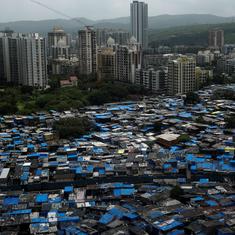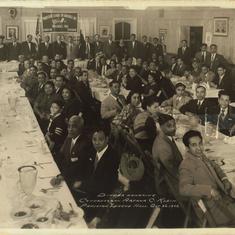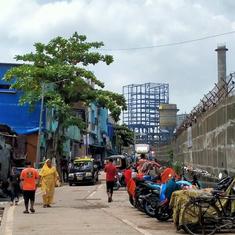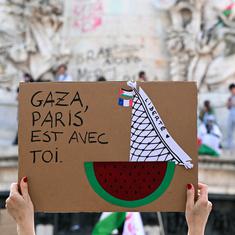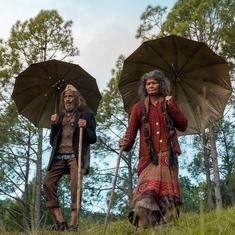Banu Mushtaq’s International Booker Prize-winning short story collection Heart Lamp is littered with a gamut of affecting objects and people: callous husbands, self-serving mutawallis, loving children, and women of all stripes. These women are, by turns, sexy, demanding, abstruse, and suffering. Kate McLoughlin notes in the Times Literary Supplement: “here are wicked in-laws, bedazzled officials, revered mother figures,” and no doubt Mushtaq’s is a literary space where “feuds fester until families are left rancid” and where “the gossip is radioactive.”
Amidst all this action, however, it was a mango tree in the story “High-Heeled Shoe” that really stood out to me as exemplary of what Mushtaq’s stories capture: the quiet brutality of the everyday life of its characters, particularly Muslim women across different class contexts in Karnataka. In the story, Nayaz Khan’s ancestral home has a large mango tree in front. It has formed a cornerpiece of his childhood memories with his brother. Over the years, he has gained from the solicitude enabled by it: “he would give baskets upon baskets of the fruit to his colleagues”. He has also made money by selling the fruit, but he is now increasingly irritated by the fact that it occupies monetizable real estate. Its felling triggers copious tears from his wife Arifa, as the tree’s sour fruit had fed her first pregnancy’s cravings, and builds a tomb over his brother’s memories of the tree’s cool shade. Around the felled mango tree, simmering tensions in the family come to a boil, resulting in an irreconcilable breakdown of communication and relationships.
Reading from Bangalore
Similar tragedies prevail in nearly every story in Mushtaq’s work, whether in the translated collection or in the six Kannada short story collections from which Deepa Bhasthi curated the final prize-winning set. I procured the original set from the popular Bangalore bookstore Bookworm, which I have frequented since their original location in a small alley of MG Road in the 2000s before their move to a bigger, leafier location on Church Street. The celebration and jubilation about the prize that has followed in the state – covered extensively by local newspapers such as the Kannada Prajavani, and the English daily Deccan Herald – has meant that Mushtaq’s publishers have worked double-time to fulfil the demand for her work. Bookworm, for one, has had to restock the Kannada collected edition of all her short fiction since the win. Aside from the global audience who are only just discovering Mushtaq’s brilliance, it is not only the non-Kannadiga audiences in India who have joined this belated circle of cheerleaders, but also Kannada readers who were largely unaware of Mushtaq’s impressive oeuvre before the win.
Many readers are asking about the Kannada original of Banu Mushtaq's Heart Lamp.
— Bookworm Bookstore, Blr (@bookworm_Kris) May 22, 2025
Copies of ಹಸೀನಾ ಮತ್ತು ಇತರ ಕಥೆಗಳು are available with us at ₹675/- after discount. Kindly visit us for your copy or whatsapp to 9845076757 for home delivery (all-India). pic.twitter.com/NtJ0ppGmdK
When I told my mother about Mushtaq’s win, she raised her eyebrows quizzically in response to the International Booker Prize’s existence. She is only an occasional reader of Kannada fiction, and mostly works by women writers, if at all. My mother is also from Mushtaq’s hometown, Hassan, which is about three hours from Bangalore. When asked about her work, she reminisced: “I haven’t read her, but I’ve heard of her. When I was staying in my sister’s house in Hassan just before marriage, around 1987, there was a girl in my neighbour’s house who was named Banu. Whenever my uncle visited our house, he would ask her, ‘Yen samaachara Banu Mushtaq?’ (What’s the latest news, Banu Mushtaq?) because she was very outspoken. She was quite well known in Hassan even then.”
The last time I caught her reading anything at all was when she was squinting at her phone, engrossed in the Kannada stories on the Pratilipi website. After I ordered the Kannada consolidated collection, my mother refused to read the stories because she resolutely believes the only reasonable justification for reading fiction is to turn its way for the purpose of delight – and firmly away from the tragedies of real life. But my idea of strategically placing the thick tome in our living room seems to have resulted in her reluctance thawing. “I started reading the first story and had to go away to do some work, and I lost the page. Of course I’ll read the book – what do you mean?” she asked me indignantly, miffed at my presumptuousness when I prompted her again after a respectable interval.
I hope she will read it with an open mind, as it is tragedy which is the dominant theme in Mushtaq’s work. The story “Stone Slabs for Shaista Mahal” narrates a snapshot in the life of the eponymous character Shaista, who succumbs to the rigours of multiple pregnancies. Her husband’s hyperbolic declarations of love are belied by his choice to replace her in a trice with a second wife after her death. Another story, “Black Cobras,” recounts the plight of Aashraf, whose husband, Yakub, abandons their family after the birth of three successive daughters. She is then seen literally and metaphorically “banging on the grand door of Allah’s house” for justice.
This story’s original, “Karinagarugalu,” was adapted into the movie Hasina by auteur Girish Kasaravalli. The movie earned a National Film Award for the Kannada actress Taara, alongside two other National awards for best costume design and best film on family welfare. For readers unable to read Kannada, it is an excellent way to experience the language’s spoken form in Mushtaq’s stories. (It is available to watch in full, with English subtitles, on YouTube.)
As Bhasthi notes in her translator’s note at the end of the book, “Against Italics,” Mushtaq’s work shows an easy “code-switching between the three-four languages [Mushtaq and Bhasthi] engage with daily [which] results in a delightful mix of Kannada, Urdu, Arabic, Dakhni and a Kannada spoken by specific communities in specific localities of the Hassan region”. At home, Mushtaq speaks Dakhni, “often wrongly identified as a dialect of Urdu,” as Bhasthi notes, “but which in fact is a mix of Persian, Dehlavi, Marathi, Kannada, and Telugu,” [whereas] “Kannada is Banu’s language at work and what she encounters on the street”.
The Kannada story “Aaspathreya Ondu Dina” (“A Day at the Hospital”) is interesting in this regard. It appears in Hejje Moodida Haadi (The Path Where the Footprints Appeared), the first collection in the consolidated Kannada edition Hasina Mattu Itara Kathegalu (Hasina and Other Stories), which was first published in 2013, and later republished by Abhiruchi Prakashana in 2025 after the inclusion of a sixth collection of short stories, Hennu Haddina Swayamvara (A Female Eagle’s Swayamvara). The story narrates a day in the life of a writer named Sudha visiting her friend and doctor, Sheela, at a district hospital in Karnataka.
The various registers of Kannada, and the code-switching seen in this story, capture the social disparities visible in everyday encounters between the characters who populate these contexts. Two impoverished women approach Sheela to acquire a certification of disability which will enable them to access government welfare funds, but are thwarted by bureaucratic red tape. These women speak in a clipped version of Kannada with compound words and colloquial truncation, reflecting a rural spoken register. (“Avva! Idu nannakka. Nammavva nodkanthidlu, sathhodlu. Eega namthava bandavle.” “Madam! This is my elder sister. My mother used to look after her, but she died. Now she has come to us.”)
On the other hand, the writer and the doctor speak in a mixture of Kannada and English. Revelatory of their class status, this is also emblematic of the use of English in professional contexts across many parts of Karnataka. (Sudha tells Sheela at one point, “Aitu bidu, you are not answerable to me. Heege ‘casual’aagi vichariside.” “Leave it, you are not answerable to me. I enquired casually.”)
The only story Bhasti has picked from this collection is “Stone Slabs for Shaista Mahal.” Four are from Mushtaq’s second collection, Benki Male (Fire Rain), three from Yedeya Hanathe (Heart Lamp), one from Safira, another from Badavara Magalu Hennalla (A Daughter of the Poor is Not a Woman), and two from her final collection, Hennu Haddina Swayamvara. Many of the female protagonists of Mushtaq’s stories are educated figures who often act as ethical custodians, imparting knowledge of the world to illiterate or underprivileged counterparts, while informing them about their rights.
The protagonist of “A Day at the Hospital” is one such writer-sentry, as is Zulekha Begum in the story “Black Cobras.” Aashraf is a domestic worker in her house, where she can be found reading “fat-fat books” all day long. She encourages Aashraf to write a petition to the mosque to address the injustice she has suffered at her husband’s hands.

Women and rebellion
These characters, in particular, appear as author surrogates channelling Mushtaq’s own fiery lawyer-activist literary persona, which evolved in the context of a larger literary, cultural and political movement in the state, captured in the Bandaya and Dalita Sahitya of the 1970s and the 1980s. Bandaya Sahitya – rebellious or protest literature – in Kannada was a subversive response to the more politically conservative Navya (modernist) literary movement in Kannada. Its domination by male and upper-caste Hindu voices was vigorously contested by radical Dalit and Muslim voices, which included Mushtaq.
This is not to say that some of the better-known canonical modernist Kannada writers, such as UR Ananthamurthy or Girish Karnad, failed to be conscious of the violence enacted by hierarchies of gender and caste. (Aside from their general popularity, their works continue to circulate in popular English translations and are frequently included in undergraduate and graduate literature curricula in India and abroad.) If you momentarily set aside the more recent rise to fame of Vivek Shanbhag’s Ghachar Ghochar (2015) in Srinath Perur’s English translation, Ananthamurthy’s Samskara (1972), translated by the multilingual literary giant AK Ramanujan, is probably the best-known work of Kannada in translation the world over. A powerful critique of the caste system from the vantage point of a male Brahmin protagonist, it nevertheless fails to offer full humanness and interiority to other subaltern characters.
As Srikar Raghavan points out, female characters like Chandri in the novel do not have a completely developed inner world. Hindu women writers such as Triveni and MK Indira also had to wait a long time to be given their due in the Kannada publishing industry. Raghavan’s recently published Rama Bhima Soma (2025) is a rigorously-researched cultural investigation of modern Karnataka, and a fantastic primer for the probing reader invested in understanding the political contestations that underpinned the emergence of Muslim women writers such as those of Mushtaq and Sara Aboobacker. The combative and multi-faceted cultural icon and writer P Lankesh first gave space to both writers in his weekly publication Lankesh Patrike. In her foreword to her reprinted Kannada collection, Mushtaq expresses gratitude to him and the Bandaya writer and veteran Baraguru Ramachandrappa for “giving her writing a direction and expanding the boundaries of her thinking.”
Mushtaq’s literary expression denotes a clearing of space in the Kannada cultural sphere on many counts. As a Muslim Bandaya writer, her work is opposed not only to normative, Hindu upper-caste, male-dominated literary production in Kannada during the latter half of the 20th century, but also within the domain of political critique in and about Muslim communities in Karnataka. Her work in talking truth to power about the hypocrisies of religious orthodoxy in these communities, their oppressive and highly patriarchal religious norms, further opened a conduit to articulate a women-centric experience, which prominent male Muslim writers in Kannada also often hesitated to voice. Her call for internal reform in relation to women’s rights in these spaces landed her with a fatwa in 2000, leading to her social boycott. Her activism highlights the complex socio-cultural positionality of women in these hyper-local communities. It emphasises the need both to be uncompromising about women’s rights within them, while also bringing attention to how internal divisions have made them vulnerable to Hindu fundamentalism in contemporary India, in turn, causing a suppression of Islamic habits and practices.
As much as her writing is politically fearless, it is also deeply personal. The title piece of her prize-winning collection, Heart Lamp, tells the story of Mehrun who tries to kill herself after her family life goes horribly wrong. She is saved in the nick of time by her daughter who senses in her demeanour that something is seriously off. This harrowing story is perhaps an autobiographical echo of Mushtaq’s own brush with death after a long spell of depression post-marriage, which she has recounted with brutal honesty in a recent interview.
The women characters in Mushtaq’s stories are acutely aware of their oppression, and offer a reckoning of freedom within patriarchal contexts as a willed and continued negotiation. The story “Love Bird” from Mushtaq’s first collection is a case in point. It depicts the protagonist Sujatha switching from starry-eyed love to bitter regret and compromise after she realises the true nature of the man she chose to marry in spite of warnings from her family. The story ends with her resignation: “Thanu ondu nela, bhadrate, gaurava mattu hana – ivugaligagi avanannu ashrayisabeku. Ishte tammibbara sambandha. Kevala vyavaharika!” (She would have to give him refuge in her life for a residence, security, respect, and money. That was the extent of their relationship. Only transactional!”)
Yet another story, “Ardha Aakashada Mauna” (Half a Sky’s Silence) is epistolary in form, with the letter writer Nabeela conscientiously demanding accountability from her ex-fiancé when he chooses to marry someone else after a long engagement. The letter spells out how her desires and dreams have been shattered, and their failed relationship underscores the systemic way in which patriarchy and religion keep women reliant on men for economic and social legitimation.
After the Prize
Following the public reception of the book after the prize has been particularly interesting for me as a comparative scholar of English and Kannada writing: I am especially curious about how Kannada literature travels in translation around the anglophone world through the flows and circuits of the global prestige economy. The journalist and critic Deepanjana Pal recently observed that these are stories “written about and for women” and have characters which “are often unabashedly sentimental and dramatic, wailing at the world that restrains them, and also challenging what is considered respectable.” The title of one of Mushtaq’s stories, “Be a Woman Once, O Lord!” exemplifies this drama. But Pal also feels, “this is a volume that doesn’t draw you in as much as guilt you into finishing it…[and] the selection feels monotonous rather than diverse…[The stories] follow predictable arcs and are populated by characters who become a sad, unidimensional blur.”
Interestingly, as I was scouring the internet to gauge general opinion about the book in the lead-up to the prize announcement, this was a view that was at least partly echoed by many social-media reviewers of the International Booker Prize shortlist. Some dismissed the short story collection with a terse description of its importance – noting little else than that it captured the situated experiences of women in a socio-culturally specific landscape in Karnataka. Or assumed that a short story collection would never win the prize. Banu Mushtaq’s overwhelmingly tragic narratives certainly owe an affective debt to the political objectives of the Bandaya Sanghatane, but I suspect there is more to be explored in how it speaks to an existing cultural idiom of sentimentality in Kannada literature and popular melodramatic cinema. Particularly in movies starring the superhit actresses Shruti and Sithara in the decades parallel to Mushtaq’s literary production, this was the predominant emotional overlay which framed how similar women protagonists were portrayed in Kannada cinema, doubly condemned by their biology and patriarchy. But this is not the right place for that excursive analysis.
The discourse around the politics of its translation has also been equally fascinating, where some of my friends and translators reading the Kannada and English together have wondered what the translation choices in the work say about questions of “authenticity” or “exoticism” – even though this is, admittedly, a reductive binary. As the Booker Prize judges noted, the translation is indeed powerful because it “ruffles language to create new textures in a plurality of Englishes.” However, for me, more than estrangement and novelty, it demonstrates the ways in which many of the characters populating Mushtaq’s stories easily inhabit a continuum of hybrid, multilingual ethno-religious spaces in Karnataka. To quote the bilingual intellectual Sugata Srinivasaraju, the stories embody various forms of “rooted cosmopolitanism” in the Kannada public sphere – and there isn’t a better example of this than Banu Mushtaq and Deepa Bhasthi on the International Booker Prize stage.
CS Bhagya is a scholar who works on postcolonial Indian literature in English and Kannada. Her work on Kannada literature – on UR Ananthamurthy’s Bara (1976) – has previously appeared in The Oxford Handbook of Modern Indian Literatures (2024), edited by Ulka Anjaria and Anjali Nerlekar.


